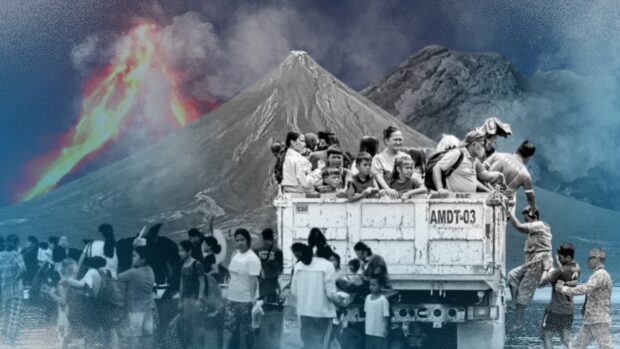LEGAZPI CITY, Albay, Philippines — Albay Gov. Edcel Greco Lagman on Monday asked officials of two towns to send home some 8,445 people, or about 44 percent of total evacuees, who were not living inside the 6-kilometer permanent danger zone of the restive Mayon Volcano.
At a press briefing, Lagman said he would recommend decampment for the 1,688 families (5,473 people) in Sto. Domingo and the 377 families (2,972 people) in Guinobatan if the two local mayors failed to justify their decision to evacuate these residents living within the 7- to 8-km extended danger zone.
He said the decision should be based on science, as the Philippine Institute of Volcanology and Seismology (Phivolcs) only recommended evacuation of the residents inside the 6-km permanent danger zone.
“There is no science behind their actions; now we are having problems on how to sustain this response effort. So, I think we need to meet as soon as possible for them to justify their actions,” Lagman said.
Sto. Domingo Mayor Joseling Aguas Jr. said the residents volunteered to seek shelter at the evacuation centers due to fear of the previous eruptions when the Mayon’s pyroclastic materials reached the 8-km extended danger zone.
“I haven’t heard the governor’s comment, but the residents willingly evacuated. You can’t control fear. They directly went to evacuation centers using tricycles,” Aguas said in an online chat message.
The town started evacuating residents from the villages of Lidong, Fidel Surtida, Sta. Misericordia and San Fernando on June 12, after noticing the lava flow in Basud Gully of the volcano.
In Guinobatan, residents were evacuated on June 9 the same day that alert level 3 (intensified unrest) was raised over the volcano due to the threat of lahar, or lava flow, as they were living near the two big gullies of the volcano, said Joy Maravillas, head of the town’s disaster risk reduction and management office.
Permanent relocation
“Our order of evacuation was solely for the welfare of the people in the said area,” Maravillas said in a separate chat message.
As of Monday, 5,751 families (19,819 people) were evacuated from the danger zone in the towns of Daraga, Camalig, Guinobatan, Malilipot and Sto. Domingo; and the cities of Ligao and Tabaco, the Albay Public Safety and Emergency Management Office (Apsemo) said in a report.
As of June this year, Apsemo recorded 4,749 families, or 18,184 people, living inside the 6-km danger zone in 14 villages.
Lagman said that after the situation has normalized, they would call for a “housing summit,” where all of the concerned national agencies would convene and talk about the plans to permanently relocate the residents inside the permanent danger zone.
He said the budgeting of the national government should also include housing and compensating those who own lots in the said areas.
Paul Karson Alanis, resident volcanologist of Phivolcs Legazpi, said on Monday that the plan to convert the volcano’s permanent danger zone into a natural park (not national park as earlier reported) could help reduce the risk posed to humans, but it requires political will to effectively implement it.
